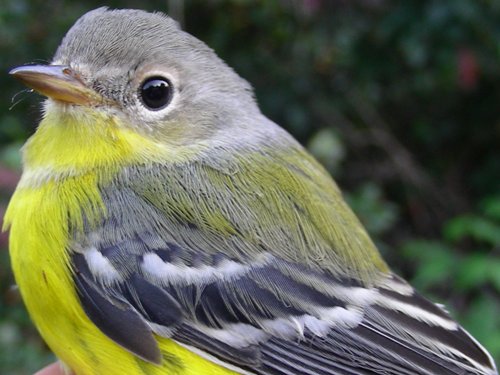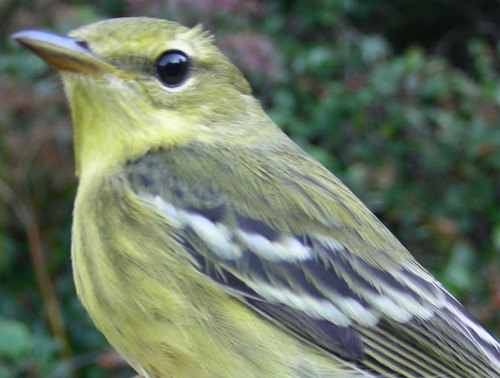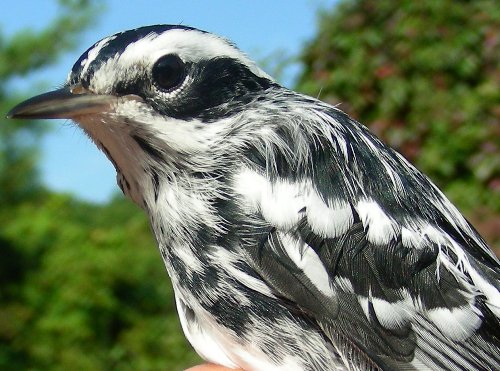|
McGILL BIRD OBSERVATORY |
|||||||||||||||||||||||||||||||||||||||||||||||||||||||||||||||||||||
Welcome
to the McGill Bird Observatory weekly report.
Click here for a complete listing of our archives.
Banders-in-charge: Barbara Frei, Marcel Gahbauer, Marie-Anne Hudson Notes: The past couple of years, the fifth week of our fall season has been a slow period following the dispersal of local breeders, and preceding the arrival of the main push of fall migrants. However, this year we were pleasantly surprised, with more birds banded in the first four days of this week than any previous full week this fall - and by the end of the week, more than twice as many as this time last year. Contributing significantly to that was our Sunday total of 68 birds banded, the busiest day yet this season; Monday with another 52 birds matched the third busiest date of the fall. Even our "worst" two days this week, with 28 birds banded, matched the busiest day from the prevoius week! We've never before had such a high count of species or individuals banded at this point in the season, nor number of species observed, and hope that our success to date is a good omen for the remainder of the fall. Not only did the number of birds in the net rise nicely this week, but also the diversity - the 44 species banded represent our best weekly total for fall since week 7 of the 2005 season. This included 18 species of warbler, with particularly noteworthy catches being an unusually early Western Palm Warbler, and a Bay-breasted Warbler, always scarce at MBO (this was just our 12th one banded over the years). However, the number of species observed this week, 82, was rather typical for this time of year. Among those seen were 7 species observed for the first time this fall: Eastern Wood-Pewee, Brown Creeper, Northern Parula, Bay-breasted Warbler, Palm Warbler, Lincoln's Sparrow, and House Finch. More than half of those (the Brown Creeper, Bay-breasted Warbler, Palm Warbler, and Lincoln's Sparrow) also paid us a visit in the nets for the first time this fall - as did Black-throated Green Warbler, Scarlet Tanager, and Purple Finch. Other banding highlights of the week included our second Black-billed Cuckoo of the season, and another five Philadelphia Vireos - a species we only caught once in 2007. Though we had just one return this week, it was interesting - our first Nashville Warbler return, caught for the first time since being banded as a heavily moulting adult on August 3, 2007. Just as the bird numbers are beginning to build, our volunteer ranks are growing too with the return of McGill students - and arrival of new ones. On Thursday, we welcomed the ornithology class for a group visit, and we look forward to seeing all members of the class returning as volunteers over the course of the remaining 8 weeks of the fall season.
Magnolia Warbler remained the most frequently banded species for a second week in a row, but shot up in numbers, with nearly three times as many of them as the Wilson's Warbler in second place. Wilson's Warblers have been increasing in numbers at MBO over the past three fall seasons, and it looks like we might be headed for another record tally this year. Again this week, warblers account for 8 of the most frequently banded species, with the only others among the top ten being Red-eyed Vireo and Yellow-bellied Flycatcher - the latter a particular surprise, as we banded just a single one all of last fall. Among the warblers, the Blackpoll was also a bit unexpected - we see them in good numbers during spring migration, but have never had more than 21 over an entire fall season. The Ovenbird count for the week was also unusually high, and the continued prominence of American Redstarts has them headed for a record season as well.
The list of species observed reflects a bit of a transition to later fall, with larger flocks of Canada Geese, Common Grackles, and Red-winged Blackbirds making appearances on numerous days. The crows remained common as usual, while the local populations of Black-capped Chickadees and American Goldfinches remain a significant presence. Magnolia Warbler, largely on the strength of the many individuals banded, was the other new entry on this week's list, jumping into the top five. Based on past years, we expect the "early warblers" such as Magnolia, Nashville, and Redstart to start tapering off in numbers over the next week or two, while the sparrows (most notably White-throated and Song) begin to increase. However, every year is different - we trust that as usual, some surprises will be awaiting us over the next week.
|



